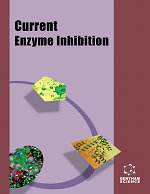- Home
- A-Z Publications
- Current Enzyme Inhibition
- Previous Issues
- Volume 20, Issue 1, 2024
Current Enzyme Inhibition - Volume 20, Issue 1, 2024
Volume 20, Issue 1, 2024
-
-
Recent Advances in Enzyme Inhibition: A Pharmacological Review
More LessEnzyme inhibition is a crucial mechanism for regulating biological processes and developing therapeutic interventions. This pharmacological review summarizes recent advances in enzyme inhibition, focusing on key developments and their implications for drug discovery and therapeutic strategies. It explains basic ideas, including the different kinds of inhibitors and how they work, and looks at recent advances in small-mo Read More
-
-
-
Natural Antioxidant Extracts as Anti-browning Agents from Algerian Date Palm Fruit
More LessAuthors: Bensania Wafa, Djeridane Amar, Bouras Noureddine and Yousfi MohamedEnzymatic browning is a negative change that affects fruits and vegetables. This makes them unfit for consumption or reduces their shelf life and quality. This reaction alters the appearance, texture, fragrance, taste, and nutritional value of the food. In order for these products to be widely accepted by consumers, it is necessary to use natural compounds with anti-browning properties. Objective The main objective of this stu Read More
-
-
-
Identification of Phenolic Profiles and In vitro Antioxidants, Neuroprotective, and Anti-diabetic Activities of Extracts from the Algerian Plant: Calendula monardii Boiss. & Reut
More LessThe present study examines the potential effect of Calendula monardii (Boiss. & Reut.) on inhibiting various enzymes involved in many diseases.BackgroundCalendula suffruticosa subsp. monardii (Boiss. & Reut.) Ohle, a medicinal plant from the Mediterranean region and, more precisely, from the extreme northeast of Algeria, is characterized by its wide use in the traditional medicine of the local population. This Read More
-
-
-
Antioxidant and Hepatoprotective Effects of L-Glu and NAC against CCl4-induced Oxidative Damage in Rats. Biochemical and Histopathological Evaluation
More LessAuthors: Nataliya Salyha and Yuriy SalyhaBackgroundThe imbalance between free radical formation and antioxidant defence leads to the development of oxidative stress. The search for substances that would mitigate or prevent the effects of oxidative stress remains relevant.ObjectiveOur goal was to compare the antioxidant and mitigation effects of L-glutamic acid (L-Glu) and N-acetylcysteine (NAC) alone or in combination using a battery of biomarkers of oxidativ Read More
-
-
-
Insight into JNK Inhibition-based Strategy for the Treatment of Alzheimer's Disease
More LessBackground Existing drugs for the treatment of Alzheimer's disease do not meet the basic requirements. Therefore, it is necessary to search for fundamentally new targets for the discovery of drugs for Alzheimer's disease (AD). When creating approaches to stimulate neurogenesis, such a search is promising to conduct as part of the development of a strategy for targeted regulation of intracellular signal transduction in reg Read More
-
-
-
Neuroprotective Potential of Orientin with Antiepileptic Drugs against Pentylenetetrazole-induced Kindling Model and Evaluation of Behavioral Assessment in Mice
More LessAuthors: Aman Shrivastava, Jeetendra K. Gupta and Kamal ShahBackgroundThe neuroprotective effect of bioflavonoids has been demonstrated in epileptic disorder.ObjectiveThe objective of this study was to investigate the anticonvulsant and adjuvant effects of the bioflavonoid and explore behavioural responses of orientin (Ore) on kindled mice induced by pentylenetetrazole [PTZ].MethodsAlbino Swiss mice weighing 20-30 g were divided into nine groups [n=6]. Prior to the PTZ dose, alte Read More
-
-
-
Metabolite Profiling and in silico Studies to Elucidate the Anti-inflammatory Properties of Pterocarpus milbreadii
More LessAuthors: Patrick Emeka Aba and Ismaila Onuche OdugboBackground Pterocarpus milbreadii (PM), called Rosewood in English, is a leafy vegetable used in preparing soup and has also proven medicinal. Objective This study aimed to evaluate the most abundant compounds in the ethylacetate fraction of PM using Gas Chromatography-Mass Spectrometry (GC-MS) and docking it against cyclooxygenase isoenzymes. Methods The PM leaves were extracted with ethylacetate usi Read More
-
-
-
A QSAR and Pharmacophore Survey on Tyrosine Kinase Inhibitors with Effect on Epidermal Growth Factor Receptor
More LessAuthors: Atefeh Hajiagha Bozorgi and Fatemeh SamadiBackgroun Tyrosine kinases are of great importance nowadays in cancer treatment. As designing new inhibitors with more potency is an optimal goal of pharmaceutical companies, using previous improvements in this area would be beneficial. One of the most popular and widely used methods is creating a QSAR model. Another useful way is to build a pharmacophoric map to address important features of inhibitors. M Read More
-
Volumes & issues
-
Volume 20 (2024)
-
Volume 19 (2023)
-
Volume 18 (2022)
-
Volume 17 (2021)
-
Volume 16 (2020)
-
Volume 15 (2019)
-
Volume 14 (2018)
-
Volume 13 (2017)
-
Volume 12 (2016)
-
Volume 11 (2015)
-
Volume 10 (2014)
-
Volume 9 (2013)
-
Volume 8 (2012)
-
Volume 7 (2011)
-
Volume 6 (2010)
-
Volume 5 (2009)
-
Volume 4 (2008)
-
Volume 3 (2007)
-
Volume 2 (2006)
-
Volume 1 (2005)
Most Read This Month
Article
content/journals/cei
Journal
10
5
false
en


